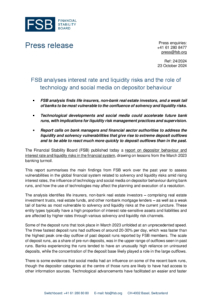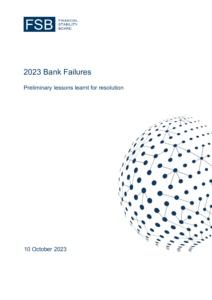Over 2022 and 2023, interest rates rose significantly in a number of advanced economies, following a decade where rates had remained at historically low levels. Rate increases were higher and faster than generally expected, resulting in significant valuation losses and sometimes precipitous increases in funding costs or liquidity risks. A number of bank deposit runs took place in the period following these interest rate rises, which represented the most serious disruption to the banking sector in more than a decade.
This report summarises the main findings from FSB work over the past year to:
- assess vulnerabilities in the global financial system from the intersection of solvency and liquidity risks in an environment of higher interest rates;
- investigate the deposit runs, including the role of technology, social media and interest rates on depositor behaviour; and
- assess how the use of technologies may affect banks’ and authorities’ planning and execution of a resolution.
The report finds that the three entity types most vulnerable to a combination of solvency and liquidity risks at the current juncture are: (i) a weak tail of banks, (ii) life insurers, and (iii) non-bank real estate investors. The report also finds that technological advancements have facilitated an easier and faster transfer of deposits in recent years and that there is some evidence that social media had an influence on some of the recent bank runs.
The findings in this report raise issues that are relevant for bank managers, supervisors, regulators, resolution authorities and policy makers. The report concludes with policy implications.

